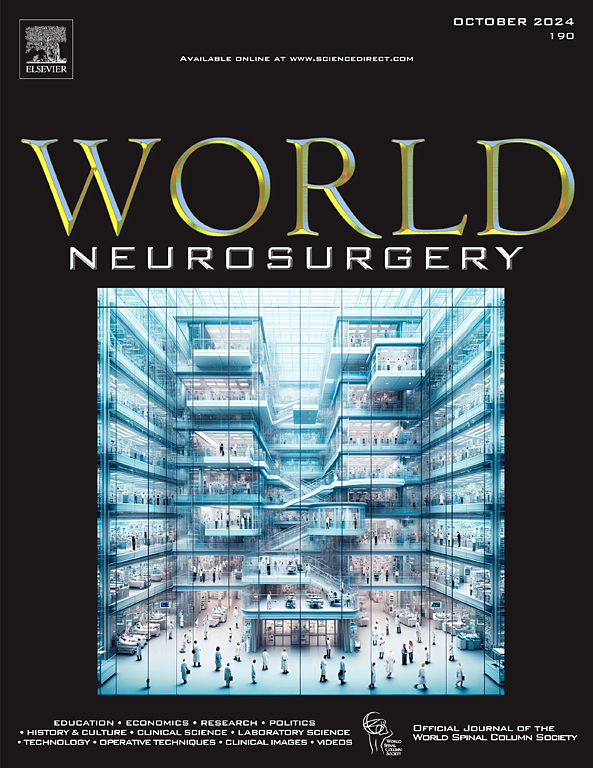Construction and Evaluation of a Prognostic Columnar Graphic Model for Adult Patients with Diffuse Midline Gliomas
IF 1.9
4区 医学
Q3 CLINICAL NEUROLOGY
引用次数: 0
Abstract
Objective
To explore the prognostic factors of adult patients with diffuse midline glioma (DMG), and to further construct and evaluate prognostic columnar graphic models to provide some reference for the clinical management of this group of patients.
Methods
We included adult patients with histologically confirmed DMG from the SEER (Surveillance Epidemiology and End Results) database (2004–2015), dividing them into training and validation sets (7:3 ratio). Using Kaplan-Meier and Cox regression analyses, we determined independent prognostic factors for overall survival (OS) and cancer-specific survival (CSS). Prognostic column-line graphic models were developed for OS and CSS, incorporating patient demographics and clinical characteristics. The models underwent internal and external validation, with performance assessed using the Concordance Index, area under the curve values, and calibration plots.
Results
The study encompassed 226 patients, showing age, tumor extension, and World Health Organization grades as significant prognostic factors. The constructed models for OS and CSS showed moderate reliability and predictive accuracy, with Concordance Index values of 0.786 (OS) and 0.79 (CSS) in the training set and 0.743 (OS) and 0.787 (CSS) in the validation set. Calibration plots and decision curve analysis confirmed the clinical usefulness of the models.
Conclusions
The column-line graphic prediction models for OS and CSS have moderately reliable predictive efficacy and help clinicians to better assess the prognosis and provide individualized treatment options for adults with DMG.
成年弥漫性中线胶质瘤患者预后柱状图形模型的建立与评价。
目的:探讨成年弥漫性中线胶质瘤(DMG)患者的预后影响因素,进一步构建和评价预后柱状图模型,为该组患者的临床管理提供参考。方法:我们从监测流行病学和最终结果(SEER)数据库(2004-2015)中纳入组织学证实的成年DMG患者,将其分为训练组和验证组(7:3比例)。使用Kaplan-Meier和Cox回归分析,我们确定了总生存期(OS)和癌症特异性生存期(CSS)的独立预后因素。为OS和CSS建立了预后柱线图形模型,纳入患者人口统计学和临床特征。模型进行了内部和外部验证,并使用一致性指数(C-index)、曲线下面积(AUC)值和校准图评估了模型的性能。结果:该研究包括226例患者,揭示年龄、肿瘤扩展和世界卫生组织(WHO)分级是重要的预后因素。构建的OS和CSS模型具有中等的可靠性和预测精度,训练集的c指数值分别为0.786 (OS)和0.79 (CSS),验证集的c指数值分别为0.743 (OS)和0.787 (CSS)。校正图和决策曲线分析(DCA)证实了模型的临床实用性。结论:OS和CSS的柱线图形预测模型具有中等可靠的预测效果,有助于临床医生更好地评估成人DMG的预后并提供个性化的治疗方案。
本文章由计算机程序翻译,如有差异,请以英文原文为准。
求助全文
约1分钟内获得全文
求助全文
来源期刊

World neurosurgery
CLINICAL NEUROLOGY-SURGERY
CiteScore
3.90
自引率
15.00%
发文量
1765
审稿时长
47 days
期刊介绍:
World Neurosurgery has an open access mirror journal World Neurosurgery: X, sharing the same aims and scope, editorial team, submission system and rigorous peer review.
The journal''s mission is to:
-To provide a first-class international forum and a 2-way conduit for dialogue that is relevant to neurosurgeons and providers who care for neurosurgery patients. The categories of the exchanged information include clinical and basic science, as well as global information that provide social, political, educational, economic, cultural or societal insights and knowledge that are of significance and relevance to worldwide neurosurgery patient care.
-To act as a primary intellectual catalyst for the stimulation of creativity, the creation of new knowledge, and the enhancement of quality neurosurgical care worldwide.
-To provide a forum for communication that enriches the lives of all neurosurgeons and their colleagues; and, in so doing, enriches the lives of their patients.
Topics to be addressed in World Neurosurgery include: EDUCATION, ECONOMICS, RESEARCH, POLITICS, HISTORY, CULTURE, CLINICAL SCIENCE, LABORATORY SCIENCE, TECHNOLOGY, OPERATIVE TECHNIQUES, CLINICAL IMAGES, VIDEOS
 求助内容:
求助内容: 应助结果提醒方式:
应助结果提醒方式:


